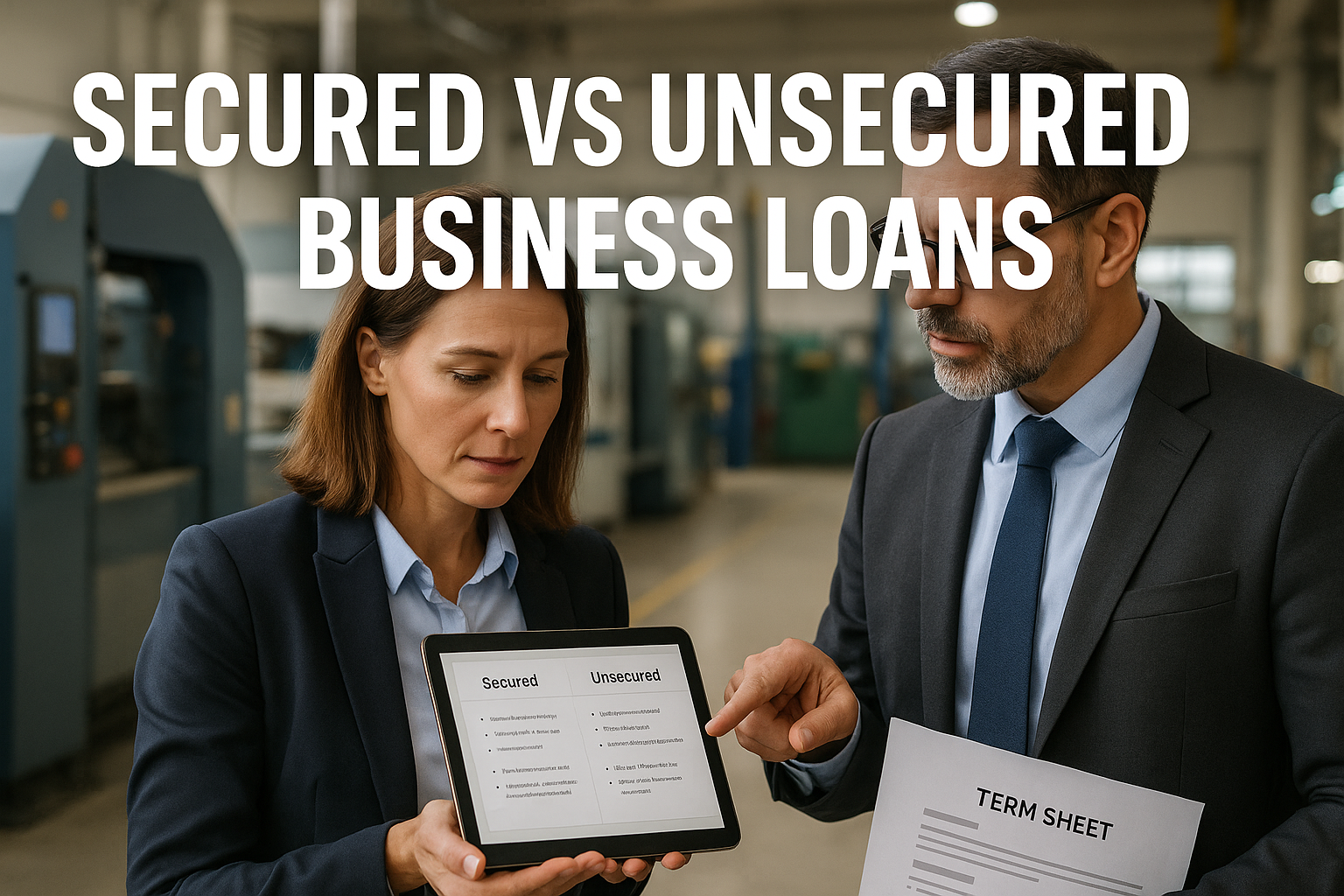1 (800) 584-0324
Choosing between secured vs unsecured business loans can feel like a coin toss—until you understand how lenders evaluate risk, price capital, and structure terms. In this guide, we break down the mechanics, costs, timelines, and approval factors so you can pick the structure that best fits your balance sheet and growth plans.
Secured vs Unsecured Business Loans: Quick Definitions
- Secured loan — Backed by collateral (e.g., equipment, receivables, real estate). Lenders file liens (e.g., UCC in the U.S.), and pricing is typically lower because asset coverage reduces loss risk.
- Unsecured loan — No specific collateral pledge. Approval relies more on cash flow strength, credit quality, and business fundamentals. Rates are usually higher and terms shorter.
Because the trade-offs are material, many teams compare secured vs unsecured business loans during annual planning or when refinancing working capital lines.
7 Proven Differences You Need to Know
1) Collateral & Liens
The most obvious divider in secured vs unsecured business loans is collateral. Secured facilities may require first-position liens on assets, sometimes with carve-outs. Unsecured loans avoid asset pledges but often include personal guarantees or negative covenants to offset risk.
2) Cost of Capital (Rate & Fees)
All else equal, secured pricing is lower. Unsecured lines command a premium for higher risk. Also consider fees (origination, monitoring, collateral exams) and any prepayment language.
3) Speed to Funds
Underwriting and documentation are simpler for many unsecured products, so funds can arrive faster—useful for time-sensitive opportunities. Secured deals add appraisals, lien searches, and filings, which can extend timelines in the secured vs unsecured business loans decision.
4) Borrowing Capacity
Asset-heavy companies can access larger limits with secured structures (e.g., ABL against AR/inventory/equipment). If assets are light, unsecured may still work—but typically with smaller limits in the secured vs unsecured business loans comparison.
5) Covenant & Reporting Load
Secured loans often carry borrowing bases, field exams, and tighter covenants. Unsecured loans may shift emphasis to cash flow metrics (DSCR), revenue trends, and credit quality—still rigorous, but different.
6) Default Remedies & Risk Allocation
If things go sideways, secured lenders can recover through pledged assets. Unsecured lenders rely on guarantees or restructure negotiations. This asymmetry is central in secured vs unsecured business loans and shows up in legal docs and pricing.
7) Strategic Flexibility
Secured liens can limit future financing options or delay M&A closings. Unsecured debt may preserve optionality, which matters in multi-lender stacks or when you anticipate asset sales—another reason founders model both in secured vs unsecured business loans planning.
Pros and Cons at a Glance
Secured Loans — Pros
- Lower interest rates on average
- Higher potential limits if you’re asset-rich
- Attractive for capex, ABL, and refinancing
Secured Loans — Cons
- Liens and collateral management
- Longer diligence and closing timelines
- May constrain future financing flexibility
Unsecured Loans — Pros
- Faster approvals and simpler documentation
- No asset pledges or valuations
- Useful for short-term working capital or bridge needs
Unsecured Loans — Cons
- Higher rates and generally smaller limits
- Shorter terms and stricter cash-flow scrutiny
- Personal guarantees more common
Which Is Right for You? A Practical Framework
When deciding between secured vs unsecured business loans, score each factor 1–5 (5 = very important):
- Speed — Do you need capital inside 2–4 weeks?
- Cost of Capital — Will rate/fee differences materially affect margins?
- Asset Base — Do you have clean, valuable collateral with clear title?
- Cash Flow Strength — Are DSCR and trends robust enough for unsecured pricing?
- Future Flexibility — Are you planning M&A, equipment sales, or a new facility?
- Reporting Tolerance — Team capacity for borrowing bases, field exams, etc.?
- Risk Appetite — Comfort with liens vs guarantees?
If Speed, Flexibility, and Reporting dominate, unsecured may edge out. If Cost, Capacity, and Asset Base lead, secured is often the better fit. Many companies blend both, laddering maturities and matching structures to use cases—a balanced approach to secured vs unsecured business loans across the year.
Industry Snapshots (U.S. & Canada)
- Construction & Field Services: Secured equipment loans/leases align with asset-heavy profiles; unsecured working capital can bridge mobilization gaps.
- Healthcare Practices & Labs: Secured equipment financing supports imaging/diagnostics; unsecured lines help with payer delay cycles.
- Tech & Digital Services: Asset-light firms often start with unsecured term loans or revenue-based facilities, then add secured lines as receivables scale.
Seasonal note for 2025: with rate volatility and cautious underwriting, proactive packaging (clean financials, AR aging, updated tax filings) can swing outcomes in secured vs unsecured business loans decisions.
How Lenders Actually Evaluate Risk
- Cash Flow & DSCR: Trailing 12-month performance, margin stability, and coverage projections.
- Collateral Coverage (for secured): AR eligibility, inventory advance rates, equipment FMV.
- Credit Profile: Business and guarantor credit strength.
- Documentation Hygiene: Up-to-date corporate records, licenses, insurance, and tax status.
- Use of Funds & Payback Logic: Clear ROI story improves terms in both secured vs unsecured business loans paths.
Smart Ways to Improve Your Approval Odds
Whether you choose secured vs unsecured business loans, these steps help:
- Right-size the request — Match tenor to asset life or cash-conversion cycle.
- Package a lender-ready file — 24 months of financials, projections, cap table, AR aging, customer concentration, debt schedule.
- Consider blended structures — For example, secured equipment financing plus an unsecured working-capital line.
- Shop the market strategically — Different lenders excel in different niches; curated outreach matters.
- Mind covenants — Negotiate headroom before you need it.
Need help packaging your file? Explore how we structure and compare options at Agile Solutions (internal link).
Common Myths About Secured vs Unsecured Business Loans
- “Unsecured means no personal guarantee.” Not always; many lenders still require PGs.
- “Secured is always cheaper.” Often—but credit strength, industry volatility, and deal size can blur the gap in secured vs unsecured business loans.
- “Liens kill flexibility.” They can limit options, but intercreditor agreements and carve-outs often preserve room to maneuver.
External Resources Worth Bookmarking
- U.S. Small Business Administration on Collateral & Guarantees
- Government of Canada: Canada Small Business Financing Program (CSBFP)
- BDC (Canada) explainer on secured/unsecured lending basics
- Investopedia primer on business loan types and terminology
(These are educational references; your situation may require tailored structuring.)
Ready to compare quotes, terms, and covenants side-by-side? Agile Solutions acts as your trusted financial partner, structuring lender-ready files and negotiating terms across our multi-lender network in the U.S. and Canada.
👉 Book a consultation today at agilesolutions.global or email us at info@agilesolutions.global
#BusinessFinancing #PrivateDebt #CapitalMarkets #MergersAndAcquisitions #CommercialLending #WorkingCapital #EquipmentFinancing #ABL #TermLoan #CashFlowLending



